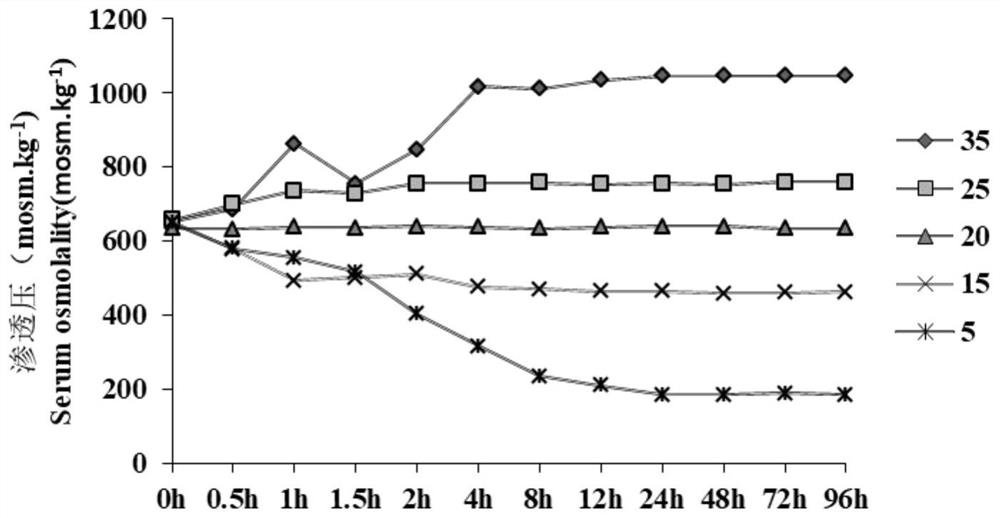Method for screening sinonovacula constricta with strong salt tolerance by utilizing osmotic pressure
A technology of osmotic pressure and razor clam, which is applied in the field of breeding new varieties of razor clam, can solve the problems of low breeding efficiency and poor effect, and achieve the effects of simple operation, strong salt tolerance, and rapid environmental adaptability
- Summary
- Abstract
- Description
- Claims
- Application Information
AI Technical Summary
Problems solved by technology
Method used
Image
Examples
Embodiment 1
[0028] The present invention utilizes osmotic pressure to screen the method for strong salt-tolerant ability of razor clams, comprising
[0029] (1) Preprocessing:
[0030] Take healthy adult razor clams with no damage on the outside, and keep them in a recirculating aquaculture aquarium for a week. The salinity of the water body is 20.47, the pH is 8.1, and the water temperature is 25.12°C. Continuously aerate them to adapt to the environment. Feed the mixed algae of Chrysophylla and Chaetoceros 2 times, and the amount of input is 5% of the mass of razor clams;
[0031] (2) Group salinity stress treatment:
[0032] 5 experimental groups of 5, 15, 20, 25, 35 water body salinity are set, and 50 constricted razor clams processed by step (1) are put into each group, and the salinity stress experiment is carried out;
[0033] (3) Determination of osmotic pressure
[0034] At 0, 0.5, 1, 1.5, 2, 4, 8, 12, 24, 48, 72, and 96 hours after the experimental stress, the razor clams in ...
Embodiment 2
[0038] The present invention utilizes osmotic pressure to screen the method for strong salt-tolerant ability of razor clams, comprising
[0039] (1) Preprocessing:
[0040] Take healthy adult razor clams with no damage on the outside, and keep them in a recirculating aquaculture aquarium for a week. The salinity of the water body is 19.53, the pH is 7.9, and the water temperature is 21.26°C. Continuously inflate them to adapt to the environment. Feed the mixed algae of Chrysophylla and Chaetoceros 2 times, and the amount of input is 5% of the mass of razor clams;
[0041] (2) Group salinity stress treatment:
[0042] 5 experimental groups of 5, 15, 20, 25, 35 water body salinity are set, and 50 constricted razor clams processed by step (1) are put into each group, and the salinity stress experiment is carried out;
[0043] (3) Determination of osmotic pressure
[0044] At 0, 0.5, 1, 1.5, 2, 4, 8, 12, 24, 48, 72, and 96 hours after the experimental stress, the razor clams in...
Embodiment 3
[0048] The present invention utilizes osmotic pressure to screen the method for strong salt-tolerant ability of razor clams, comprising
[0049] (1) Preprocessing:
[0050] Take healthy and undamaged adult razor clam shells and keep them in a recirculating aquaculture aquarium for a week. The salinity of the water body is 21.41, the pH is 8.3, and the water temperature is 28.98°C. Continuously inflate them to adapt to the environment. Feed the mixed algae of Chrysophylla and Chaetoceros 2 times, and the amount of input is 5% of the mass of razor clams;
[0051] (2) Group salinity stress treatment:
[0052] 5 experimental groups of 5, 15, 20, 25, 35 water body salinity are set, and 50 constricted razor clams processed by step (1) are put into each group, and the salinity stress experiment is carried out;
[0053] (3) Determination of osmotic pressure
[0054] At 0, 0.5, 1, 1.5, 2, 4, 8, 12, 24, 48, 72, and 96 hours after the experimental stress, the razor clams in each group...
PUM
 Login to View More
Login to View More Abstract
Description
Claims
Application Information
 Login to View More
Login to View More - R&D
- Intellectual Property
- Life Sciences
- Materials
- Tech Scout
- Unparalleled Data Quality
- Higher Quality Content
- 60% Fewer Hallucinations
Browse by: Latest US Patents, China's latest patents, Technical Efficacy Thesaurus, Application Domain, Technology Topic, Popular Technical Reports.
© 2025 PatSnap. All rights reserved.Legal|Privacy policy|Modern Slavery Act Transparency Statement|Sitemap|About US| Contact US: help@patsnap.com

